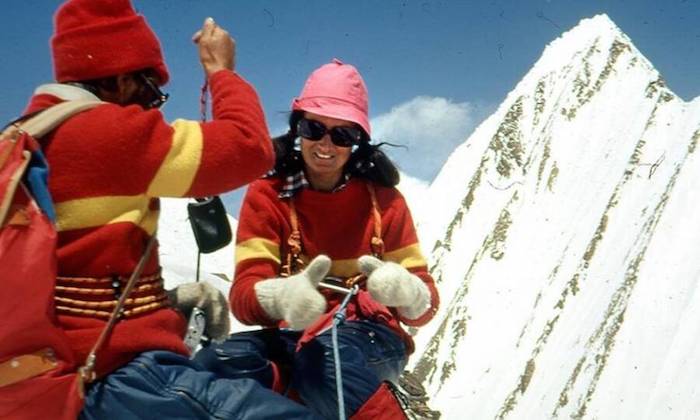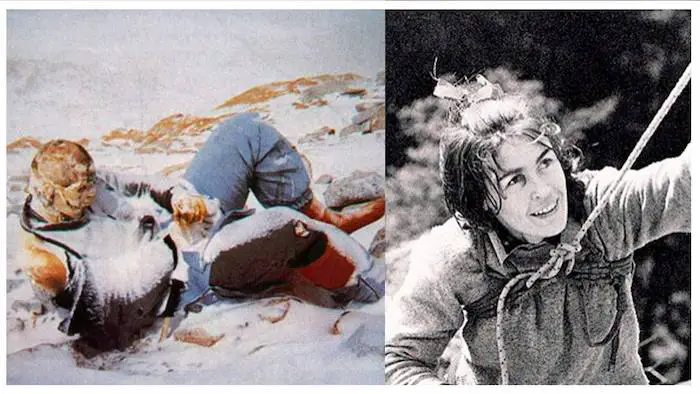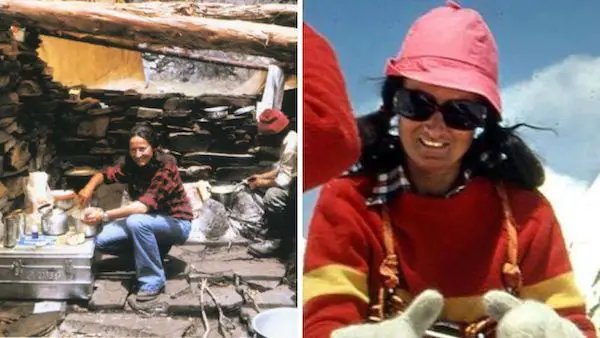In 1979, Hannelore Schmatz, a passionate German mountaineer, embarked on her most daring expedition yet: conquering the summit of Mount Everest. Her successful ascent marked a significant achievement as Schmatz became the fourth woman in the world to reach the highest peak in the world.
Tragically, the descent from the summit proved to be a harrowing ordeal that claimed Schmatz’s life. She became the first woman and the first German national to die on Mount Everest. Now over 50 years later, Hannelore Schmatz is one of the most famous dead bodies on Mount Everest.
This blog recounts the life of Schmatz and the events that aspired during her expedition on Everest.
Hannelore Schmatz was An Experienced Climber:
Hannelore Schmatz and her husband, Gerhard Schmatz, were a pair of experienced mountaineers who had ventured far and wide in pursuit of the world’s most formidable peaks.
In May 1973, after a successful expedition to the summit of Manaslu, the eighth highest peak in the world towering at 26,781 feet above sea level, Hannelore and Gerhard returned to Kathmandu, Nepal. Without missing a beat, they quickly set their sights on their next audacious climb.
For reasons unbeknownst to many, the couple resolved that the time had come to conquer the highest mountain on Earth, Mount Everest. They submitted their request for a climbing permit to the Nepalese government and began preparing for the adventure.
Over the years, the duo steadily climbed higher peaks each year to enhance their acclimatization to high altitudes. As time went on, the mountains they tackled grew taller. Following a successful ascent of Lhotse, the fourth highest peak in the world, in June 1977, they finally received word that their request to climb Mount Everest had been approved.
Hannelore, whom her husband hailed as “a genius when it came to sourcing and transporting expedition materials,” diligently oversaw the technical and logistical arrangements for their Everest endeavor. Whereas, in the 1970s, sourcing adequate climbing gear in Kathmandu was still a challenge. Therefore, they needed to ship all the equipment required for their three-month expedition to Everest’s summit from Europe to Kathmandu.
Hannelore Schmatz secured a warehouse in Nepal to store their equipment, which weighed several tons in total. In addition to the gear, they also had to assemble their expedition team. Alongside Hannelore and Gerhard Schmatz, six other seasoned high-altitude climbers joined them on the journey to Everest.
Among their comrades were Nick Banks from New Zealand, Hans von Känel from Switzerland, Ray Genet from the United States—an expert mountaineer with whom the Schmatzs had previously undertaken expeditions—and their fellow German climbers, Tilman Fischbach, Günter Fuchs, and Hermann Warth. Hannelore was the sole woman in the group.
By July 1979, all preparations had been meticulously completed, and the group of eight, accompanied by five Sherpas, set out on their trek, ready to conquer the mighty Everest.
Hannelore’s Summit Push on Mount Everest:

During the ascent, the group trekked to an altitude of approximately 24,606 feet, to a section known as “the yellow band.” They proceeded to traverse the Geneva Spur in order to reach the camp at the South Col, a narrow and sharp mountain ridge situated at the lowest point between Lhotse and Everest. At an elevation of 26,200 feet, on September 24, 1979, the group decided to establish their final high camp.
However, an intense blizzard struck, forcing the entire camp to descend back to Camp III. Afterward, they made another attempt to return to the South Col, this time splitting into two larger groups. During this attempt Hannelore Schmatz was separated from her husband, as she joined one group composed of other climbers and two Sherpas, while the rest accompanied her husband.
Gerhard’s group successfully reached the South Col after a three-day climb and halted to set up camp for the night. Reaching the South Col marked a critical milestone, as it signaled the final stage of their ascent towards the summit of Everest.
While Hannelore Schmatz’s group was still making their way back to the South Col, Gerhard’s group embarked on their early morning hike towards Everest’s peak on October 1, 1979. Around 2 p.m., his group reached the summit of Mount Everest, with Gerhard Schmatz becoming the oldest person to summit the world’s highest peak at the age of 50. Despite the celebration, Gerhard expressed concern about the hazardous conditions from the southern summit to the peak.
The group swiftly began their descent, encountering similar challenges to those they faced during their climb. When they safely arrived back at the South Col camp at 7 p.m, Hannelore’s group had already set up camp in preparation for their own summit push.
Gerhard’s group cautioned Hannelore and the others about the treacherous snow and ice conditions, attempting to dissuade them from proceeding. However, Hannelore, described by her husband as “indignant,” remained determined to conquer the mighty mountain.
Hannelore Schmatz’s Tragic Death on Everest:
In the early hours of the morning, Hannelore Schmatz and her group commenced their climb from the South Col. As Hannelore ascended, her husband Gerhard started his descent back to the base of Camp III due to rapidly deteriorating weather conditions.
Around 6 p.m., Gerhard received news over the expedition’s walkie-talkie communication that his wife and the rest of the group had successfully reached the summit. Hannelore Schmatz became the fourth female mountaineer in the world to conquer Everest’s peak.
However, Hannelore’s descent proved perilous. According to surviving group members, both Hannelore and the American climber Ray Genet, became too exhausted to continue. They decided to halt and establish a bivouac camp before resuming their descent.
Sherpas Sungdare and Ang Jangbu, accompanying Hannelore and Genet, cautioned against their decision. They were in the deadly region known as the Death Zone, where climbers are most vulnerable to life-threatening conditions. The sherpas advised the climbers to press on, aiming to reach the base camp further down the mountain.
Genet had reached his limit and remained behind, tragically succumbing to hypothermia. Deeply shaken by the loss of their fellow climber, Hannelore and the two remaining sherpas decided to continue their descent. Unfortunately, it was too late—Hannelore’s body had already succumbed to the unforgiving environment. As recounted by the sherpa who was with her, her final words were a plea for water as she sat down to rest. It was there that she passed away, leaning against her backpack.
Ultimately, Hannelore Schmatz was the first woman and the first German to lose her life on the slopes of Mount Everest.
Schmatz’s Corpse: The German Woman on Everest

After her tragic demise on Mount Everest at the age of 39, Gerhard, her husband, expressed the following heart-wrenching sentiment,
“Nevertheless, the team returned home. But I returned alone, without my beloved Hannelore.”
Hannelore’s lifeless body remained at the exact spot where she took her last breath, frozen along the path many other Everest climbers would traverse. The condition of her body attracted attention from climbers, as she remained frozen in place along the mountain’s southern route, still clad in her climbing gear and garments. Her eyes stayed open, and her hair danced in the wind. Fellow climbers began referring to her as the “German Woman.”
Arne Næss Jr., a Norwegian mountaineer and expedition leader who successfully reached the summit of Everest in 1985, shared his encounter with her lifeless body:
“I cannot escape the eerie presence. About 100 meters above Camp IV, she sits, leaning against her backpack, as if taking a brief rest. A woman with wide-open eyes and hair swaying with each gust of wind. It is the corpse of Hannelore Schmatz, the wife of the leader of a 1979 German expedition. She conquered the summit but perished on the descent. Yet, it feels as if her eyes follow me as I pass by. Her presence serves as a reminder that we are at the mercy of the mountain’s conditions.”
In 1984, a Sherpa and a Nepalese police inspector attempted to recover Hannelore’s body, but tragically, both men lost their lives in the process. After that ill-fated attempt, the mountain eventually claimed Hannelore Schmatz. A gust of wind propelled her body, and it tumbled over the edge of the Kangshung Face, disappearing where no one would ever lay eyes upon it again, forever lost to the elements.
Hannelore Schmatz’s Legacy:
Schmatz’s lifeless body, until it vanished, resided within the treacherous Death Zone, where the extremely low oxygen levels at 24,000 feet deprive climbers of their ability to breathe. There are 200 dead bodies on Everest, many of them positioned in this perilous Death Zone.
Despite the presence of snow and ice, Everest remains predominantly dry in terms of relative humidity. This means that bodies are well preserved in the elements, serving as reminders and cautionary tales to those who dare to push to Everest’s summit. Among the most renowned of these bodies, apart from Hannelore’s, is George Mallory, who attempted to summit Everest in 1924. Climbers discovered his remains 75 years later in 1999.
Until 2007, one out of every ten climbers who ventured towards the pinnacle of the world’s highest peak did not survive to recount their tale. Regrettably, the death rate has increased and worsened since 2007 due to the rise in frequent expeditions to the summit.
Exhaustion, perhaps coupled with confusion, ultimately claimed Hannelore Schmatz’s life. Although it would have been more sensible to make their way back to base camp, the experienced climber somehow believed that taking a break was the wiser choice. In the end, within the Death Zone above 24,000 feet, the mountain always emerges victorious when confronted with one’s weakened resolve to continue.
Hannelore Schmatz “The German Woman” on Everest:

Hannelore Schmatz’s mummified remains were a haunting sight for climbers on the southern route for many years. Positioned against her backpack, with her frozen body, wide open eyes, and hair blowing in the wind, she served as a stark cautionary symbol for those brave enough to take on the mighty mountain.
Although her body eventually vanished, falling from the Kangshung Face, Hannelore Schmatz’s tragic fate continues to linger in the thoughts of climbers and adventure enthusiasts. Her story emphasizes the utmost importance of respecting the mountain, recognizing one’s limitations, and making well-informed choices when navigating the perilous Death Zone.
FAQs: Hannelore Schmatz “The German Woman” on Everest
Below are the most frequently asked questions regarding the German Woman on Everest, Hannelore Schmatz.
No, Hannelore Schmatz’s body is no longer on Mount Everest. Her body was initially visible to climbers on the southern route, but it eventually disappeared, tumbling over the side of the Kangshung Face.
Hannelore Schmatz was the German woman on Everest. She was the fourth woman to ever summit Everest, as well as became the first woman to ever die on Everest in 1979.
In 1979, Hannelore Schmatz, became the first German woman to summit Everest. Sadly, during her descent, she succumbed to exhaustion and died just above Camp IV. She became the first woman to die on Everest.
